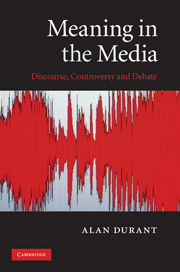Book contents
- Frontmatter
- Contents
- Acknowledgements
- Introduction
- Part I Communication failure and interpretive conflict
- Part II Making sense of ‘meaning’
- Part III Verbal disputes and approaches to resolving them
- Part IV Analysing disputes in different fields of law and regulation
- 9 Defamation: ‘reasonably capable of bearing the meaning attributed’
- 10 Advertising: ‘not only what is said, but what is reasonably implied’
- 11 Offensiveness: ‘If there is a meaning, it is doubtless objectionable’
- Part V Conclusion
- References
- Index
11 - Offensiveness: ‘If there is a meaning, it is doubtless objectionable’
Published online by Cambridge University Press: 05 June 2012
- Frontmatter
- Contents
- Acknowledgements
- Introduction
- Part I Communication failure and interpretive conflict
- Part II Making sense of ‘meaning’
- Part III Verbal disputes and approaches to resolving them
- Part IV Analysing disputes in different fields of law and regulation
- 9 Defamation: ‘reasonably capable of bearing the meaning attributed’
- 10 Advertising: ‘not only what is said, but what is reasonably implied’
- 11 Offensiveness: ‘If there is a meaning, it is doubtless objectionable’
- Part V Conclusion
- References
- Index
Summary
Introduction
In this chapter I consider some underlying communicative distinctions that seem essential in shaping debate over offensiveness. My aim in doing so is to clarify the role played in the ‘offensiveness’ of a discourse by that elusive attribute, its ‘meaning’. Discourse ranging from local, abusive comment through to sustained hate speech is felt to be offensive by different groups of people on a number of grounds. Adjudication in such circumstances, I show, typically involves assessing how far an allegedly offensive discourse expresses a viewpoint or alternatively how far it carries out an action (such as encouraging a crime or inflicting a violent verbal or symbolic assault). Arriving at a judgment in such situations depends on deciding – however that decision is actually formulated – as to the speech-act force, or ‘performativity’, of the material in question. Such decisions are arrived at despite the force of an utterance or text being not so much a settled convention as a matter of context-specific implication.
Meaning and boundaries of acceptability
Legend has it that when the artist Antonin Artaud, who had written the screenplay, attended the premier of the silent film The Seashell and the Clergyman (1928), directed by Germain Dulac, he was so angry with what she had done to his script that he got up and shouted at the screen, calling her a ‘cow’. Artaud was reputedly unhappy with Dulac's realisation of his scenario.
- Type
- Chapter
- Information
- Meaning in the MediaDiscourse, Controversy and Debate, pp. 199 - 224Publisher: Cambridge University PressPrint publication year: 2010



